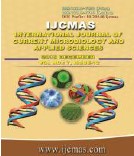


 National Academy of Agricultural Sciences (NAAS)
National Academy of Agricultural Sciences (NAAS)

|
PRINT ISSN : 2319-7692
Online ISSN : 2319-7706 Issues : 12 per year Publisher : Excellent Publishers Email : editorijcmas@gmail.com / submit@ijcmas.com Editor-in-chief: Dr.M.Prakash Index Copernicus ICV 2018: 95.39 NAAS RATING 2020: 5.38 |
Antibiotic resistance is a growing problem in pediatric urology as nonselective use of prophylaxis, and poor empiric prescribing practices. The feacal reservoir provides optimal conditions for the transmission of resistance genes within and between bacterial species as gut is exposed to large number of bacteria. So, this study was undertaken for the knowledge of drug resistance among uropathogens and also revises the possible role of the intestinal microbiota as a reservoir of drug resistant bacteria. Out of 344 urine samples, from 0-14 age group 124 samples had significant growth yielded 134 isolates. Escherichia coli was most predominant isolate 71(53%) Antibiotic resistance of Enterobacteriaceae isolates for cephalosporins was 48%, Ampicillin 62%, amoxiclav 50%, Ciprofloxacin19%, levofloxacin10.3%, norfloxacin 43%, Nitrofurantoin 6%, gentamicin 12%, amikacin 2.8%, piperacillin -tazobactam 14% and carbapenems 2.8%. Commensal E. coli from same patient showed 56.3% resistance to cephalosporin whereas urinary E. coli which was 53.5%. Aminopenicillins resistance was also high in both isolates. Resistance to Norflox 21% in feacal E. coli and 53.5% in urinary E. coli, which was higher among other fluoroquinolones. Aminoglycoside, Nitrofurantoin, Carbapenems had 0-2%antibiotic resistance. Resistance to some of the most commonly prescribed primary care antibiotics in feacal isolates suggest that one cause of carrying bacterial resistant feacal flora could be previous exposure to antibiotics. So Future research must prioritize understanding resistance in non-pathogenic bacteria, which could allow prescribing guidelines to be updated before it affects patient therapeutic outcomes.
Escherichia coli, Urinary tract infections, Antibiotic resistance, Pediatrics, Antibiotic prophylaxis, Antibiogram
 |
 |
 |
 |
 |